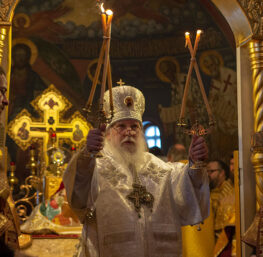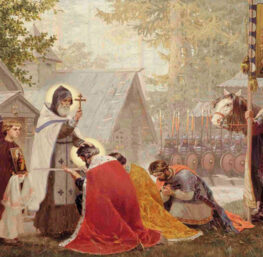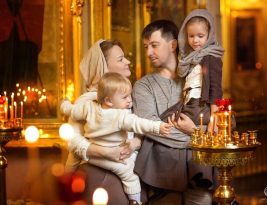The Grand Rapids Press Juanita Westaby July 01, 2006
GRAND RAPIDS — When The Rev. Moses Berry was a child, his mother told him: “We are all flowers in God’s garden.” But he remembers thinking: “Where were the flowers in God’s garden that looked like me?”
The question was tucked into the back of his mind, when he grew up as a third-generation African Methodist Episcopal pastor’s son.
Today, he is an Orthodox priest who speaks nationwide about bringing African Americans and people from other ethnic backgrounds into his adopted faith. He might do it with something simple: prayer cards with icons that feature saints with dark skin.
Berry, of Ash Grove, Mo., was one of the speakers at the 13th annual Ancient Christianity and African-American Conference in Detroit last weekend.
Berry spoke of his journey to Orthodoxy, which includes jail time. He said he and his wife, Magdalena, then became “new age, nondenominational pastors.”
“Ex-flower children, Jesus freaks,” he said.
But a friend, who wanted him to experience something new, asked him to visit a church in Richmond, Va. There was talk about the Mother of God. There was a different language at times. There was incense.
“Normally, we would revile against that,” Berry said.
But the icons caught his eye, especially one of St. Moses the Ethiopian.
“He had nostrils like I had,” Berry said. “He had lips like mine. He had coarse hair.”
Then, he looked at the icon of St. Cyprian of Carthage. “And I thought, ‘Oh my goodness, these must be the flowers who looked like me,'” Berry said. “I knew I was home.”




I have known Fr. Moses for over 30 years and had the great good fortune to share part of his journey with him. I have heard him speak in formal settings and have listened to him share in quiter moments. Even before he was introduced to St. Moses, the Ethiopian, I have seen Fr. Moses, with quiet dignity, respond to other black people in the inner city of Detroit who accused him of being an Uncle Tom because of his adherence to the “white man’s” religion.
He is a fine, good man who comes from deep roots of faith. A brief quote from a chapter he wrote in the book An Unbroken Circle: Linking Ancient African Christianity to the African-American Experience, Fr. Pasisuis Altschul, ed.
His grandmother often warned him to guard the scared experience for it could so easily be misused by saying:
The book is a compliation of a series of presentations at the 3rd annual Ancient Christianity and African-American Conference that was held in Indianapolis, IN. The impetus for these conferences came frim Fr. Pasius and his parish, St. Mary of Egypt, in Kansas City. He has another book Wade in the River as well.
In Ash Grove, Fr. Moses great-grandfather, a freeman, established a cemetary in which to bury first his family and then other blacks who were not accepted by the white cemetaries. Since becoming an Orthodox priest, Fr. Moses has consecrated that cemetary, and established a museum of his hertiage and that of many on his family’s land. I shall be visiting soon.